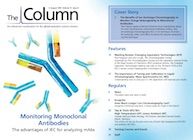The Importance of Tuning and Calibration in Liquid Chromatography–Mass Spectrometry (LC–MS)
An excerpt from LCGC’s professional development platform, CHROMacademy.com, on the importance of tuning and calibration in liquid chromatography–mass spectrometry (LC–MS).
Zffoto/stock.adobe.com

An excerpt from LCGC’s professional development platform, CHROMacademy.com, on the importance of tuning and calibration in liquid chromatography–mass spectrometry (LC–MS).
The importance of tuning and calibration of a mass spectrometer in liquid chromatography–mass spectrometry (LC–MS) cannot be overemphasized. Tuning and calibration is performed to ensure that the mass spectrometer is working correctly, or that the spectra (mass assignment and relative abundance of spectral signals) resemble a previously determined standard. The tuning process will check that spectrometer contamination or degraded electronic components have not changed the assigned mass positions (calibration of the mass axis); that repeatable analysis from instrument to instrument (or laboratory to laboratory) is ensured; and that the spectrometer gives expected relative ratios of ion fragment intensities for a target compound. Tuning acts as a diagnostic tool to indicate the service or cleaning requirements of the spectrometer; it provides a chronicle of system performance, and the matching of fragments from a known calibration compound so as to adjust the mass axis so it agrees with the expected mass assignments. Tuning is essential for all types of mass analyzers, and at high resolution or for trace analysis instrument tuning will help to define attainable resolution and sensitivity.
Tuning
The voltages applied to the various ion source components must be tuned to achieve target ion abundances for various analyte ion masses. This ensures optimal instrument sensitivity and a predictable response across a range of masses. During tuning, the relative and absolute abundances of fragments of a known tuning compound are established, and the mass assignment, resolution, and spectral peak width generated by the mass analyzer are also adjusted and set. The tuning process involves adjusting several mass spectrometer parameters that affect signal processing, as well as voltages and currents associated with ion source components, the mass analyzer, and detector. Because atmospheric pressure ionization-mass spectrometry (API-MS) produces little fragmentation from a single ion, liquid chromatography–mass spectrometry (LC–MS) calibration and tuning is usually carried out using a mixture of compounds. Many substances are available for calibrating the m/z scale, including compounds such as bovine ubiquitin, cesium salts, lysozyme, sugar mixtures, and solvent clusters. Proprietary solutions have also been developed by different instrument manufacturers. For many years, polyethylene glycol (PEG) and polypropylene glycol (PPG) were the most widely used calibrants for LC–MS. However, these compounds are very sticky, and tend to remain in the system for long periods, so their use is falling out of favour.
Mass Alignment
All mass spectrometers are calibrated to specify how masses are assigned to peaks. This is done by constructing a calibration curve based upon the mass spectrum of a known reference standard.
Peak Heights
Quadrupole mass spectrometers require calibration to achieve a standardized abundance versus mass response, to correct for any mass discrimination inherent in the mass analyzer. This is done by tuning peak heights for a standard sample. Peak heights can be influenced by other types of analyzers, but the quadrupole case is the best example.
Quantitation
Quantitative methods such as selected ion monitoring (SIM) require the creation of a calibration curve based on the response of varying quantities of a standard sample. SIM or selected reaction monitoring (SRM) methods require some calibration of the mass spectrometer so that the masses or reactions will be accurately monitored.
Peak Shape and Ion Source Tuning
The mass spectrometer parameters must all be adjusted to give both good sensitivity and good peak shapes for a standard reference compound at some specified resolution value.
Mass Axis Calibration
Calibration is done using infused tune compounds that contain spectral lines due to ions whose mass is known to the level of accuracy required, such as unit mass values for quadrupole mass analyzers or accurate mass values for double focusing magneticâsector mass analyzers. These compounds cover the required operating mass range, with the ions being as evenly spaced as possible. The instrument software tunes the mass axis to a set of preâprogrammed tune masses by altering the electronic configuration of the mass analyzer, that is the mass gain and offset for the quadrupole or magnetic field strength for the sector instruments. Mass axis calibration should be independent of the API technique used for ion generation, so long as the calibrant is capable of efficient ionization under a given set of interface conditions. Mass axis calibration is carried out at regular intervals, such as at the beginning of each working day or prior to a campaign of analysis, depending on the laboratory and its applications. When working at high resolution where high mass accuracy is required, a lock mass compound may need to be constantly infused alongside the analyte. This is particularly prevalent with timeâofâflight (TOF) mass analyzers, where there may be a tendency for the mass axis to drift, due to the highly sensitive nature of the mass analyzing device.
More Online: Find this, and other webcasts, at www.CHROMacademy.com/Essentials (free until 20 September).

New Method Explored for the Detection of CECs in Crops Irrigated with Contaminated Water
April 30th 2025This new study presents a validated QuEChERS–LC-MS/MS method for detecting eight persistent, mobile, and toxic substances in escarole, tomatoes, and tomato leaves irrigated with contaminated water.

.png&w=3840&q=75)

.png&w=3840&q=75)



.png&w=3840&q=75)



.png&w=3840&q=75)










